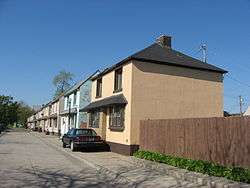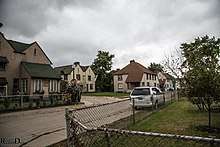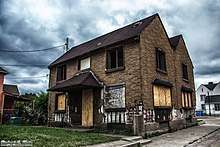Marktown
Marktown is an urban planned worker community in East Chicago, Indiana, United States,[2] built during the Progressive Era in 1917 from marshland to provide a complete community for workers at The Mark Manufacturing Company.[3]
Marktown Historic District | |
 Houses on Park Street | |
  | |
| Location | Bounded by Pine, Riley, Dickey, and 129th Sts., East Chicago, Indiana |
|---|---|
| Coordinates | 41°39′32″N 87°28′4″W |
| Area | 40 acres (16 ha) |
| Built | 1917 |
| Architect | Howard Van Doren Shaw |
| NRHP reference No. | 75000025[1] |
| Added to NRHP | February 20, 1975 |
The Marktown Historic District was added to the National Register of Historic Places in 1975.[1]




History
The community of Marktown was founded by Clayton Mark, a pioneer maker of steel in the United States. The renowned architect hired to design the community, Howard Van Doren Shaw, created a unique design in which the streets serve as walkways and the cars are parked on the sidewalks, as noted in Ripley’s Believe It or Not.[4] Shaw previously designed Mark's estate in Lake Forest, Illinois.[5]
Only 10% of the original design was built, as the building of the community was terminated due to the aftereffects of World War I and the sale of the Mark Manufacturing Company. Today, Marktown is one of the few planned worker communities in which all of the originally constructed homes still stand.[6] The industries in East Chicago expanded to the borders of Marktown, surrounding the historic residential island with one of the densest industrial complexes in the world.[6] It was added to the National Register of Historic Places in 1975,[1] and was listed as one of the seven wonders of Northwest Indiana.[2]
Marktown is regarded as an important cultural resource of architectural and historical significance. In the words of the Marktown Revitalization Plan commissioned by the city of East Chicago in 2008, "Marktown is significant as it is a major work by a significant American architect, Howard Van Doren Shaw, for its association with the driving economic force of industry that served as an identity of the region, and is representative of the planned industrial community movement of the late 19th and early 20th century."[7]
Much of Marktown has been demolished and only 20% of the original community remains.[8]
References
- "National Register Information System". National Register of Historic Places. National Park Service. July 9, 2010.
- Smith, Stephanie; Mark, Steve (2011). "Marktown: Clayton Mark's Planned Worker Community in Northwest Indiana". South Shore Journal. 4.
- "Indiana State Historic Architectural and Archaeological Research Database (SHAARD)" (Searchable database). Department of Natural Resources, Division of Historic Preservation and Archaeology. Retrieved 2016-05-01. Note: This includes Richard Morrisroe (January 1975). "National Register of Historic Places Inventory Nomination Form: Marktown Historic District" (PDF). Retrieved 2016-05-01. and Accompanying photographs.
- Ripley’s Believe It or Not!. 15. New York: Pocket Books. 1967.
- Skertic, Mark (2003). A Native's Guide to Northwest Indiana. Native's Guide. Lake Claremont Press. p. 64. ISBN 978-1893121089.
- Marktown: Clayton Mark’s Planned Worker Community in Northwest Indiana
- Marktown Revitalization Plan (December 2008). Prepared by Bauer Latoza Studio for the City of East Chicago.

